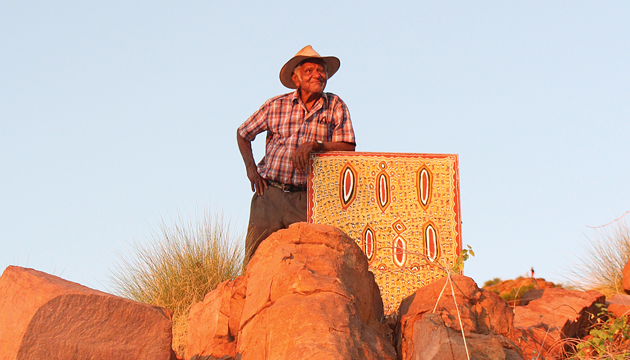West Australian artist Alan Griffiths is helping to preserve culture by painting and performing corroborees.
Story Sue Wallace Photo Frances Andrijich
Tiny whimsical figures dance across Alan Griffiths’ many corroboree paintings. Look closely and his arm-waving ‘dot’ figures are mostly different, with some wearing ceremonial dance adornments and carrying traditional musical instruments, such as didgeridoos and music sticks, that reveal much about the featured corroboree.
Alan, 84, says corroborees are important events that tell stories, pass on cultural traditions to younger generations and honour ancestors. Sitting under a shady boab in the dusty grounds of Kununurra’s Waringarri Aboriginal Arts with his artist wife Peggy and two daughters, Dora and Jan, Alan is talking about his art. In a few hours, a grand Corroboree under the Stars that he has orchestrated will be staged as part of the annual Ord Valley Muster. The excitement is building as eager children wearing brightly coloured clothes and body paint run by.
“We get groups coming from all around to participate in the corroboree, and many come and watch,” Alan says. “We need to pass on these traditions to younger ones.”
Music and dance have always been important to Alan, who was born at Victoria River Downs in the Northern Territory and worked on various stations across the Top End. He moved around a lot, finding employment as head stockman at Katherine’s Beswick station, Elsey station near Mataranka, Maninbelli station, Elizabeth Downs, Delamere and Willaroo.
In 1965 he married Peggy, who was promised to him in childhood, and later they moved to Wyndham, where he turned his hand to plumbing, before settling at Newry station as a stockman, then a cook and finally as a tractor driver on a cotton farm at Ivanhoe station.
He has previously spoken about his early struggles and how he narrowly escaped from a welfare raid on Victoria River Downs. As a young boy, he was tied to a tree while police were contacted to pick him up the next day, but his grandfather waited until members of the party were asleep and cut him free, and went bush with him. “My grandfather said, ‘Throw away those boots and clothes,’ and I learnt about country,” he says. He returned to the station three years later, when he was old enough not to be noticed by the welfare department. “My grandfather was a clever man,” he says.
Alan didn’t find much time for painting until he retired in the 1980s. His paintings reflect his love of music and dance, his respect for tradition and his position as a leading senior lawman with authority throughout the Victoria River and Kimberley regions.
Alan has a distinctive style that showcases his attention to detail and meticulous reflection on cultural life, including corroborees, camel treks and cattle mustering. Some of his ochre and pigment paintings tell stories of cultural celebrations, while others are more abstract and map large significant landmarks.
This story excerpt is from Issue #116
Outback Magazine: December/January 2018










